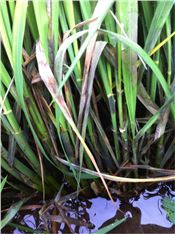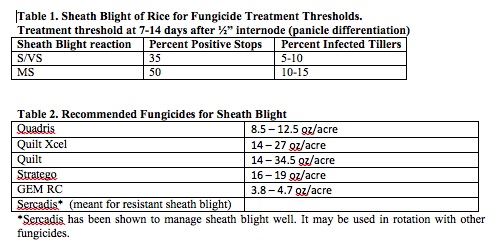Rice Sheath Blight
DR. YESHI WAMISHE
FAYETTEVILLE, ARK.
Sheath blight is a major disease of rice in Arkansas. It is caused by a soil pathogen and the fungus has several hosts including soybean and corn among others. It prevails in any rice field if conditions are right for the fungus to develop. Prolonged periods of high humidity and high temperatures favor the sheath blight disease to start and progress. The fungus mostly survives as “sclerotia” (tiny masses of fungal structure called “mycelia”) which are capable of floating on flooded rice fields. The floating fungal structures coming in contact with the growing rice and infect the sheath at or just above the waterline and spread throughout the plant tissue. The infection progresses upward through the canopy and to adjacent plants. Areas with the thickest stands and heaviest nitrogen use often show severe sheath blight disease. Sheath blight every so often starts at panicle initiation (green-ring) to panicle differentiation (1/2” internode elongation) and its development and spread can continue throughout the season. Therefore, scouting for sheath blight is recommended from green ring to pre-heading. The optimum fungicide treatment timing usually is 7-14 days past panicle differentiation (Table 1).
However, decisions on fungicide application depends on varietal susceptibility, the height of the variety, weather condition, the field management (seeding rate and nitrogen fertilizer rate), and the treatment threshold (Table 1). For unfamiliar eyes, sheath blight may be confused with other diseases such as “aggregate sheath spot”, “bordered sheath spot”, “stem rot”, or “black (crown) sheath rot”. These diseases have not required fungicide applications to date. Therefore, correct diagnosis of the disease before fungicide application is also important. Protection of at least the upper three leaves including the flag leaf is highly recommended to reduce grain yield loss. Susceptible shorter cultivars can be severely damaged compared to taller cultivars, and the damage can occur quickly under favorable conditions for sheath blight. Note that there is no complete resistance in cultivars to sheath blight. However, if all is done right, a fungicide application would give the desired level of sheath blight control for susceptible or moderately susceptible cultivars. Research has shown that fungicides work better in well managed fields.
SCOUTING:
“The entire field should be scouted for symptoms in a zigzag pattern stopping every 50 steps. Only a 3-ft long section of rice should be inspected at each stop for sheath blight symptoms. If symptoms are present the stop is positive. A minimum of 50 stops per field should be made or one per acre to determine the level of sheath blight for the field. If sheath blight is not widespread in the field, but concentrated in certain areas, then treating only those areas with the fungicide may be more economical. While experience may be substituted for scouting in fields with a history of sheath blight, the economic use of fungicides depends on adequate knowledge of the distribution of the disease in a field and its intensity between ½” internode elongation and early heading” (Source: Rick Cartwright).
On assessment of the research from Dr. Rick Cartwright the following information has been extracted. Stratego at 16 oz provided 14-17 days control, whereas the 19 oz rate for 21-24 days. Quadris at 6.4 oz provided 10-14 days control while 9 oz for about 21 days. But the full rate of 12.5 oz provided 28 days of control. Moreover, his research indicated, azoxystrobin (Quadris) to be somewhat more effective on sheath blight than trifloxystrobin (GEM) – but the difference was just slight (Source: Rick Cartwright). To read more on rates and contents of the fungicides go to: http://www.arkansas-crops.com/2015/07/02/fungicides-major-diseases/
In the last two weeks, sheath blight is being reported in a few fields. However, none were in severe situations. Field edges double drilled or double fertilized have shown a little higher level of sheath blight in a few fields (Figure 1).
Although the day temperatures these days appears unfavorable to sheath blight development, the disease may progress in fields where inoculum is active and nights are dewy and warm. Experimental plots inoculated on July 9, 2015 with temperature of the week were in high 90s produced lesions in four days. Sclerotia of the fungus have started producing mycelia and the disease appears in progress. These plots have thick canopy and were provided with excessive amount of nitrogen fertilizer. Continue scouting! ∆
DR. YESHI WAMISHE: Extension Rice Plant Pathologist, University of Arkansas

Fig. 1 Sheath blight on CL163 in double seeded edges of a field.
